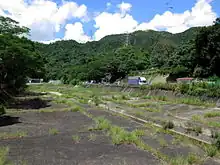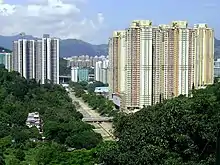

Heung Fan Liu (Chinese: 香粉寮; lit. 'fragrant powder sheds')[1] is an area in Tai Wai, Sha Tin District, Hong Kong.[2]
History
Heung Fan Liu derives its name from its former incense-making industry.[1] Incense milling may have been conducted in Heung Fan Liu as early as the late Ming dynasty.[2] It would have been processed in Heung Fan Liu and nearby Pak Tin. This local industry ceased at the time of the Great Clearance in the second half of the 17th century.[3] Early 20th century maps show sandalwood mills in the area. This industry was made possible thanks to the presence of a fast flowing stream with a substantial year-round flow of water to power the water-wheel. Sites with similar characteristics also existed in Pak Kiu Tsai (白橋仔) in Tai Po and Tso Kung Tam (曹公潭) in Tsuen Wan.[2]
In 1932, Herbert Edward Lanepart (林伯氏), a Latvian believed to be of German origin, set up a nudist club by the river in Heung Fan Liu. The club moved to Wok Tai Wan in 1936, because the lease on Heung Fan Liu was expiring and the building of Shing Mun Reservoir in 1935 had lowered the level of the river and made the water murky.[1]
Fauna
The first recorded sighting of a ashy woodswallow (Artamus fuscus) in Hong Kong took place in Heung Fan Liu on April 23, 2011.[4]
See also
References
- 1 2 3 Poon, Shuk-Wah (2022). Power and Politics at the Colonial Seaside: Leisure in British Hong Kong. Taylor & Francis. pp. 81–84. ISBN 9781000636635.
- 1 2 3 Chan, Ka-yan (陳家恩) (1989). "Joss Stick Manufacturing: A Study of a Traditional Industry in Hong Kong" (PDF). Journal of the Royal Asiatic Society Hong Kong Branch. 29: 94–120. eISSN 1991-7287. ISSN 0085-5774.
- ↑ Wei, Peh T'i (2014). "Why Is Hong Kong Called 'Fragrant Harbour': A Synthesis". Journal of the Royal Asiatic Society Hong Kong Branch. 54: 233–57. eISSN 2617-3239. ISSN 1991-7295. JSTOR jroyaaisasocihkb.54.33.
- ↑ Lambert, James (March 2013). "Ashy Woodswallow Artamus fuscus at Heung Fan Liu. The first Hong Kong record" (PDF). Hong Kong Bird Report. Hong Kong Bird Watching Society (2011): 204–206.
Further reading
- Wood, Chris (17 March 2017). "Nudism in 1932: Hong Kong in the buff". South China Morning Post.
22°22′35″N 114°10′06″E / 22.376508°N 114.168325°E